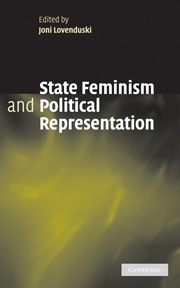Book contents
- Frontmatter
- Contents
- List of figures
- List of tables
- Notes on contributors
- Preface
- List of abbreviations
- 1 Introduction: state feminism and the political representation of women
- 2 Gendering political representation: debates and controversies in Austria
- 3 The Belgian paradox: inclusion and exclusion of gender issues
- 4 A politics for presence: state feminism, women's movements and political representation in Finland
- 5 Gendering the republican system: debates on women's political representation in France
- 6 WPAs and political representation in Germany
- 7 Gendering the debate on political representation in Italy: a difficult challenge
- 8 High tides in a low country: gendering political representation in the Netherlands
- 9 The women's movement, gender equality agencies and central-state debates on political representation in Spain
- 10 Party feminism, state feminism and women's representation in Sweden
- 11 Party government and women's representation debates: the UK
- 12 Women's policy agencies, the women's movement and representation in the USA
- 13 Conclusions: state feminism and political representation
- Appendix 1 Tables of women's representation in eleven countries
- Appendix 2 The RNGS model: summary of variable descriptors
- Index
- References
9 - The women's movement, gender equality agencies and central-state debates on political representation in Spain
Published online by Cambridge University Press: 22 September 2009
- Frontmatter
- Contents
- List of figures
- List of tables
- Notes on contributors
- Preface
- List of abbreviations
- 1 Introduction: state feminism and the political representation of women
- 2 Gendering political representation: debates and controversies in Austria
- 3 The Belgian paradox: inclusion and exclusion of gender issues
- 4 A politics for presence: state feminism, women's movements and political representation in Finland
- 5 Gendering the republican system: debates on women's political representation in France
- 6 WPAs and political representation in Germany
- 7 Gendering the debate on political representation in Italy: a difficult challenge
- 8 High tides in a low country: gendering political representation in the Netherlands
- 9 The women's movement, gender equality agencies and central-state debates on political representation in Spain
- 10 Party feminism, state feminism and women's representation in Sweden
- 11 Party government and women's representation debates: the UK
- 12 Women's policy agencies, the women's movement and representation in the USA
- 13 Conclusions: state feminism and political representation
- Appendix 1 Tables of women's representation in eleven countries
- Appendix 2 The RNGS model: summary of variable descriptors
- Index
- References
Summary
Introduction
This chapter examines the role of the Women's Institute (Instituto de la Mujer, WI) and the women's secretariat of the Spanish Socialist Workers' Party (Partido Socialista Obrero Español, PSOE) – hereafter ‘PSOE women's secretariat’ – in three central-state debates on political representation in Spain since 1983. The WI is the main central-state level women's policy office in Spain. As the analysis in this chapter demonstrates, the WI and the PSOE women's secretariat were able to represent women's movement goals and gender the frame of two debates on political representation: the discussion that in 1988 led to the adoption by the PSOE of a 25 per cent women's quota, and in 1997 resulted in the increase of this quota to 40 per cent. In the third discussion (on a mandatory 40 per cent women's quota for all parties submitted by the PSOE in 2001), an energetic PSOE women's secretariat was unable to counteract the WI, whose activities were not feminist. Women were allowed to participate in the policy process but the policy outcome (the rejection of the bill in 2003) was contrary to the demand advanced by the women's movement.
The women-friendly outcomes of the first two debates occurred under governments formed by the PSOE. The women's movement was at a stage of consolidation and the active WI and PSOE women's secretariat were attentive to the development of measures to increase women's political representation.
- Type
- Chapter
- Information
- State Feminism and Political Representation , pp. 174 - 194Publisher: Cambridge University PressPrint publication year: 2005
References
- 20
- Cited by



